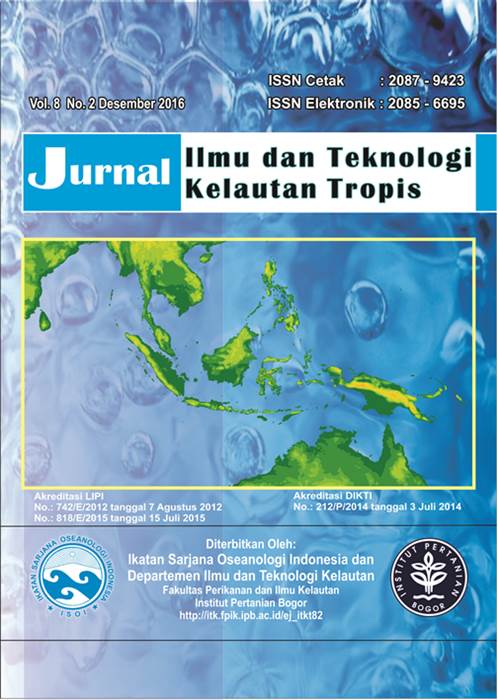GROW OUT CULTURE OF CORAL TROUT Plectropomu leopardus IN FLOATING NET CAGES WITH DIFFERENT FEEDING FREQUENCIES
Abstract
A study on the effect of feeding frequency on coral trout culture Plectropomus leopardus was conducted in floating net cages. The aim of this study was to determine an optimum feeding frequency for better growth rate and feed conversion ratio. The experiment was divided into two stages, i.e.; using fish with a range of body weight of 24 to 100 g (1st stage), and fish with a range of 100 to150 g (2nd stage). The first stage, consisted of four treatments of feeding frequencies, i.e. four times a day (4/1), three times a day (3/1), twice a day (2/1), and once a day (1/1). For the second stage experiment, the treatments applied were, three times a day (3/1), twice a day (2/1), once a day (1/1), and once in two days (1/2). Each treatment was in triplicate. At each feeding time, experimental fish were fed with dry pellets to apparent satiation. Both first and second experimental stages showed that the treatments of twice a day (2/1) feeding frequency attained significantly higher growth rates and lower feed conversion ratios than other treatments (P<0.05). Survival rate at the first stage (4/1), three times a day (3/1), twice a day (2/1), higher than (1/1) (P<0.05). But in the second stage the survival rate is not significant. The most optimum feeding frequencies for this species is 2/1 for the fish of 24 to 150 g BW.
Authors
SetiawatiK. M., Zafran., & KusumawatiD. (2017). GROW OUT CULTURE OF CORAL TROUT Plectropomu leopardus IN FLOATING NET CAGES WITH DIFFERENT FEEDING FREQUENCIES. Jurnal Ilmu Dan Teknologi Kelautan Tropis, 8(2), 605-611. https://doi.org/10.29244/jitkt.v8i2.15827
The author submitting the manuscript must understand and agree that the copyright of the article manuscript must be submitted/transferred to the Jurnal Ilmu dan Teknologi Kelautan Tropis. This work is licensed under the Creative Commons Attribution-ShareAlike 4.0 (CC BY-SA) International License in which the Author and Reader can copy and redistribute the material in any media or format, and remix, modify and build material for any purpose, but they must provide appropriate credit (citing articles or content), provide a link to the license, and indicate whether there is a change. If you mix, change, or create material, you must distribute your contribution under the same license as the original.

